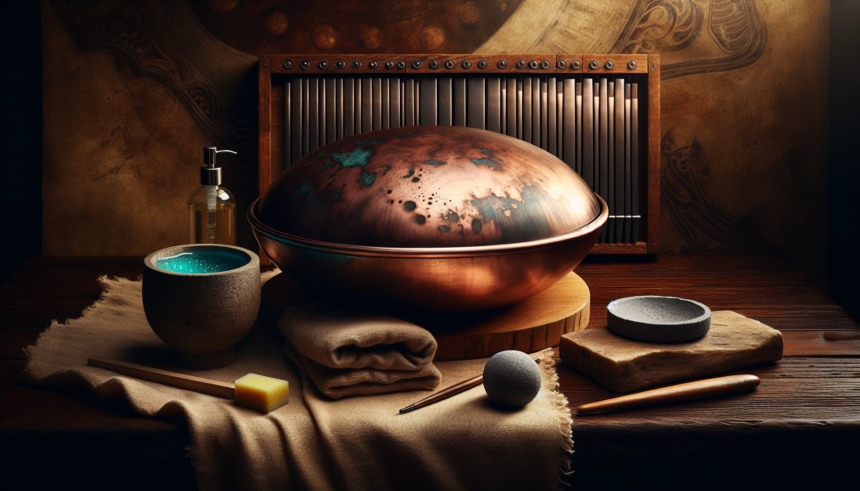<!DOCTYPE html>
<html lang="en">
<head>
<meta charset="UTF-8">
<meta name="viewport" content="width=device-width, initial-scale=1.0">
<title>Understanding Handpan Patina: Care and Preservation</title>
<style>
body {
font-family: Arial, sans-serif;
margin: 20px;
line-height: 1.6;
}
h2 {
color: #333;
}
p {
margin-bottom: 20px;
}
.faq {
margin-top: 40px;
}
.faq h2 {
margin-bottom: 10px;
}
.faq-item {
margin-bottom: 15px;
}
.faq-item p {
margin: 0;
}
</style>
</head>
<body>
<h1>Understanding Handpan Patina: Care and Preservation</h1>
<p>The handpan is not just an instrument; it is a work of art that produces enchanting, ethereal sounds. One of the unique characteristics of a handpan is the patina, the naturally occurring layer that forms on its surface over time. Understanding the patina and knowing how to care for it is crucial to preserving both the instrument's beauty and sound quality. In this article, we will delve into the science of handpan patina, how to care for it, and how to ensure your handpan remains in pristine condition for years to come.</p>
<h2>What is Patina?</h2>
<p>Patina is a thin layer that forms on the surface of metal objects due to oxidation and other chemical processes. For handpans, which are usually made from steel, this layer can provide a natural protective coating. Over time, the interaction of the metal with air, moisture, and oils from your hands can lead to the formation of patina. This process can result in a range of colors and finishes, adding to the handpan's character and aesthetic appeal.</p>
<h2>The Importance of Patina</h2>
<p>The patina on a handpan does more than just enhance its appearance. It also serves several functional purposes:</p>
<ul>
<li><strong>Corrosion Resistance:</strong> The patina acts as a barrier that protects the underlying metal from further oxidation and corrosion.</li>
<li><strong>Aesthetic Appeal:</strong> A well-developed patina can enhance the visual appeal of a handpan, giving it a unique, aged look that many players cherish.</li>
<li><strong>Sound Quality:</strong> While the primary sound generating mechanism of a handpan is its shape and tuning, the patina can also subtly influence the tone quality. A stable patina layer can help in maintaining a consistent sound.</li>
</ul>
<h2>Caring for Your Handpan Patina</h2>
<p>To ensure that your handpan's patina develops beautifully and continues to protect your instrument, it's essential to follow proper care guidelines:</p>
<h3>1. Clean Your Handpan Regularly</h3>
<p>After each use, wipe down your handpan with a soft, dry cloth to remove oils and sweat from your hands. This simple step can prevent buildup that might interfere with the formation of an even patina.</p>
<h3>2. Use Suitable Cleaning Agents</h3>
<p>If deeper cleaning is required, use a mild soap solution or a gentle cleaner specifically designed for metal instruments. Avoid harsh chemicals and abrasive materials that can damage the patina or metal surface.</p>
<h3>3. Apply Protective Oils</h3>
<p>Handpan players often use protective oils, such as those containing carnauba wax or natural oils, to help maintain the patina. These oils form a thin, protective layer that can prevent oxidation and keep the patina looking vibrant.</p>
<h3>4. Store Properly</h3>
<p>When not in use, store your handpan in a dry, cool location. Avoid exposing it to extreme temperatures or humidity, which can accelerate corrosion and affect the patina's development. Using a dedicated handpan case can provide an additional layer of protection.</p>
<h2>Common Myths about Handpan Patina</h2>
<p>There are several myths and misconceptions about patina that can lead to improper care practices. Here, we debunk some of the most common ones:</p>
<h3>Myth 1: Patina Should be Removed Regularly</h3>
<p>Some players believe that patina should be removed to keep the handpan looking new. However, removing patina can expose the metal to corrosion and diminish the instrument's natural beauty. Instead, focus on maintaining and supporting the natural patina formation.</p>
<h3>Myth 2: All Oils Are the Same</h3>
<p>While applying oil to a handpan is a common practice, not all oils are suitable. Some oils can be too heavy or contain additives that might react negatively with the metal. Always use oils recommended by handpan makers or those specifically formulated for metal instruments.</p>
<h3>Myth 3: Patina Formation Means Damage</h3>
<p>Patina formation is a natural and beneficial process, not an indication of damage. It shows that the instrument is maturing and developing character. Proper care ensures that the patina enhances the handpan rather than detracting from it.</p>
<h2>Preserving the Sound Quality</h2>
<p>While patina plays a role in protecting the handpan and contributing to its aesthetic appeal, preserving the sound quality is of utmost importance. Here are some additional tips for ensuring your handpan continues to sound as beautiful as it looks:</p>
<h3>1. Regularly Check for Rust</h3>
<p>Even with a protective patina, rust can sometimes form on a handpan, particularly in high-humidity environments. Regularly inspect your instrument for any signs of rust and address them promptly with appropriate rust removal treatments.</p>
<h3>2. Handle with Clean Hands</h3>
<p>Before playing your handpan, wash your hands to remove oils, dirt, and sweat. This simple practice helps in preventing unwanted residue from affecting the patina and sound quality.</p>
<h3>3. Avoid Excessive Force</h3>
<p>Handpans are delicate instruments. Playing with excessive force can damage the metal and interfere with the formation of a stable patina. Aim for a balanced, gentle touch to maintain both the patina and the instrument's sound.</p>
<h2>Conclusion</h2>
<p>Understanding and caring for the patina on your handpan is essential for preserving its beauty and functionality. The patina not only provides a protective layer against corrosion but also adds to the unique character of your instrument. By following proper care practices, you can ensure your handpan remains in top condition, both visually and acoustically, for many years to come. Embrace the natural aging process of your handpan, and let its patina tell the story of your musical journey.</p>
<div class="faq">
<h2>Frequently Asked Questions (FAQs)</h2>
<div class="faq-item">
<p><strong>1. How often should I oil my handpan?</strong></p>
<p>You should oil your handpan every few weeks or whenever you notice the patina starting to look dry. Regular oiling can help maintain the patina and prevent corrosion.</p>
</div>
<div class="faq-item">
<p><strong>2. Can I use household cleaning products on my handpan?</strong></p>
<p>No, household cleaning products may contain harsh chemicals that can damage the patina and the metal surface of your handpan. Use only mild soap solutions or cleaners specifically designed for metal instruments.</p>
</div>
<div class="faq-item">
<p><strong>3. Why does my handpan have different colors on its surface?</strong></p>
<p>The different colors on your handpan are a result of the patina formation process, influenced by the interaction of the metal with air, moisture, and oils. These color variations add to the unique character of your instrument.</p>
</div>
<div class="faq-item">
<p><strong>4. Is it okay to polish my handpan?</strong></p>
<p>Polishing your handpan is not recommended, as it can remove the beneficial patina layer and expose the metal to corrosion. Focus on maintaining the natural patina instead.</p>
</div>
<div class="faq-item">
<p><strong>5. What should I do if I notice rust on my handpan?</strong></p>
<p>If you notice rust on your handpan, gently remove it using a non-abrasive cloth and a rust remover designed for metal instruments. After treating the rust, apply a protective oil to prevent future occurrences.</p>
</div>
</div>
</body>
</html>Understanding Handpan Patina: Care and Preservation

Leave a comment




